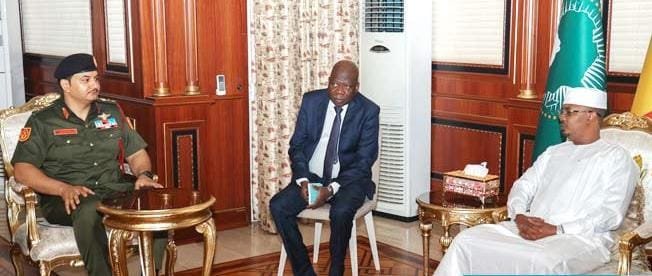A Haftar in N’Djamena… What’s Behind the Scene?

N’Djamena – Sudanhorizon
In early August, Lieutenant General Haftar, Chief of Staff of the Ground Forces of the Libyan National Army’s General Command, made an official visit to the Chadian capital, N’Djamena, where he conferred with President Mahamat Idriss Déby Itno. Despite the declared formal nature of the visit, its timing, geographical location, and regional context place it far from being merely a mere protocol. It positions it within a network of strategic considerations where the interests of three countries intersect: Libya, Chad, and Sudan.
– Consecutive Meetings
The meeting, which lasted for more than two hours, addressed public issues such as reopening the border along the Kufra-Tibesti axis, revitalizing trade, settling detainees’ status, and coordinating on immigration and smuggling issues. However, behind these headlines, there are clearer indications of deeper transformations, at a time when Darfur and West Kordofan are witnessing decisive battles waged by the Sudanese Armed Forces and their supporting forces against a rebellion seeking to rebuild its resources through loose borders and intersections of regional interests. The visit was preceded by a first visit in June 2024, when Haftar met with President Déby in an unannounced meeting, held away from the media spotlight, after the latter’s victory in the presidential elections was announced. Between the two meetings, a pivotal incident occurred when Sudanese Armed Forces units withdrew from a strategic border area near the triangle between Sudan, Egypt, and Libya, following an attack launched by the Rapid Support Forces militia. According to an official statement from the Sudanese Army General Command, the attack was carried out with logistical facilitation through Chadian territory and in coordination and partnership with armed groups linked to Haftar’s leadership in southern Libya.
– Maaten al-Sara Air Base
At the heart of this scene, the Maaten al-Sara Air Base in southern Libya plays a growing role. It is overseen by Russian special forces, whose roles go beyond aerial reconnaissance to include securing movements across the desert, supporting field allies in the border triangle, and even indirectly influencing the course of the Sudanese conflict by controlling or channeling military supplies, according to the network of interests on the ground. Haftar, considered the man of special missions in southern Libya, operates in the sandy space straddling Chad, Darfur, and Fezzan, in a non-diplomatic capacity, but with roles that extend beyond his military mandate. His presence in N’Djamena, after a long period of lull in Libyan-Chadian relations, raises fundamental questions about the nature of the alliance being formed there, and whether its goal is to control the border, manage supply lines, or expand influence.
From a Sudanese perspective, the N’Djamena scene cannot be read in isolation from Khartoum’s broader battle to protect its border security. Official accusations against Chad of supporting the rebels and overlooking the recruitment of members from shared tribes make any talk of real security cooperation between the two countries unrealistic. Indeed, Chad, in its current reality, appears more like a direct party to the war than a mediator, which necessitates redefining the relationship with it within the parameters of Sudanese national security, rather than the traditional logic of neighborliness.
– Required Roles
On the ground, the Sudanese Armed Forces continue to extend their control in the states of Darfur and West Kordofan, successfully containing the rebels and pursuing their remnants. But the most serious challenge still lies in the open supply lines across southern Libya and West Darfur, and the smuggling routes extending into Chad. Controlling this front lies not only in military operations, but also in imposing political will on the countries involved and restructuring bilateral relations strictly in line with the seriousness of the threat.
In this context, the importance of strengthening intelligence and military deployment in Adila, Tina, and Umm Dafuq emerges, and transforming the border triangle into an advanced security control zone capable of confronting any infiltration before it occurs. Diplomatic and intelligence representation must also be deployed to Fezzan to secure the Libyan border and limit any role for armed groups whose agendas are hostile to the Sudanese state.
As activity intensifies on Sudan’s western border, observers wonder whether Haftar’s visit to N’Djamena is merely a revitalization of Libyan-Chadian coordination, or whether it falls within a more complex regional architecture in which interests, pressures, and exchanged messages overlap. Is this border intended to be a corridor for stability…or an arena for recycled chaos?
Shortlink: https://sudanhorizon.com/?p=6804

